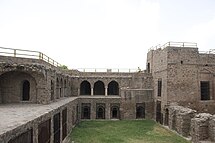Firoz Shah Palace Complex
| Firoz Shah Palace Complex | |
|---|---|
|
Native name Hindi: हिसार-ए-फिरोज़ा |
|

Inner courtyard of Firoz Shah Palace
|
|
| Location | Hisar, Haryana, India |
| Coordinates | 29°09′59″N 75°43′14″E / 29.166306°N 75.720587°E |
| Settled | 1357 |
| Founded | 1354 |
| Built | 14th century |
| Built for | Firoz Shah Tughlaq |
| Demolished | 1398 |
| Restored by | Archaeological Survey of India |
| Architectural style(s) | Islam |
| Governing body | Archaeological Survey of India |
| Lat ki Masjid | |
|---|---|
| लाट की मस्जिद | |
| Basic information | |
| Location | Hisar, Haryana, India |
| Affiliation | Islam |
| Ownership | Archaeological Survey of India |
| Architectural description | |
| Architectural type | Mosque |
| Architectural style | Seljuk |
| Date established | 1354 |
| Specifications | |
| Minaret height | 20 feet |
| Materials | Red sandstone |
| गुजरी महल | |
| Location | Hisar, Haryana, India |
|---|---|
| Material | Rubble and Mortar |
| Beginning date | 1354 |
| Completion date | 1356 |
| Dedicated to | Gujri (Mistress of Firoz Shah Tughlaq) |
| The palace is a part of Firoz Shah Palace Complex | |
Firoz Shah Palace Complex is located in front of Hisar Bus Stand in the city of Hisar in Haryana, India. It was built by Firuz Shah Tughlaq in 1354 AD. The original town of Hisar was a walled settlement inside the fort with four gates, Delhi gate, Mori gate, Nagauri gate and Talaqi gate. The palace consists of a mosque known as Lat ki Masjid. Lat is a sandstone pillar about 20 feet high and was earlier an Ashokan pillar. Underground apartments are also located inside the complex. The place has also a Diwan-e-Aam. Gujri Mahal is another palace located near the palace complex also built by Firoz Shah for his wife Gujri. Its construction was completed in 1356 and stands on a massive rectangular platform.
Jahaj Kothi Museum, named after George Thomas, is located inside Firoz Shah Palace Complex and maintained by Archaeological Survey of India.
The palace, known as Hisar-i-Firuza, located at a strategic point where the old Delhi Multan Road route branched to Khorasan (historic region which lies in northeast of Iran), was built by Firoz Shah Tughlaq in 1354. The construction was completed in 1356. The palace consists of a mosque, a Diwan-e-Aam, a palace for his wife, underground apartments and a granary. The restoration work of the palace started in 1924 and have since been gradually renovated until recent times. The complex has been declared as a Centrally Protected Monument by Archaeological Survey of India.
The artwork in the fort is the synthesis of Islamic architecture and Indian architecture. However, the mosque was built in Seljuk architecture.The palace is built of red sandstone. The material used in the construction of the fort was taken from the destroyed Hindu temples.
...
Wikipedia

